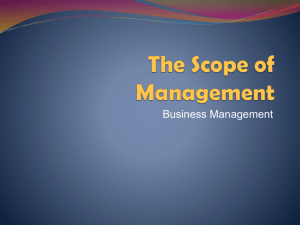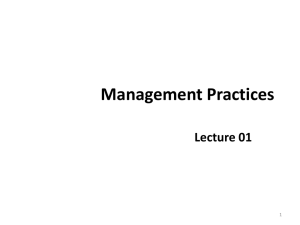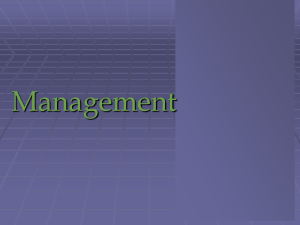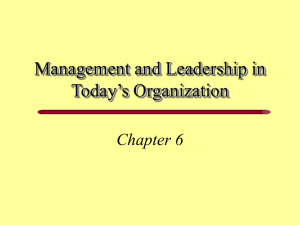IT Management Principles: P-O-L-C Framework
advertisement
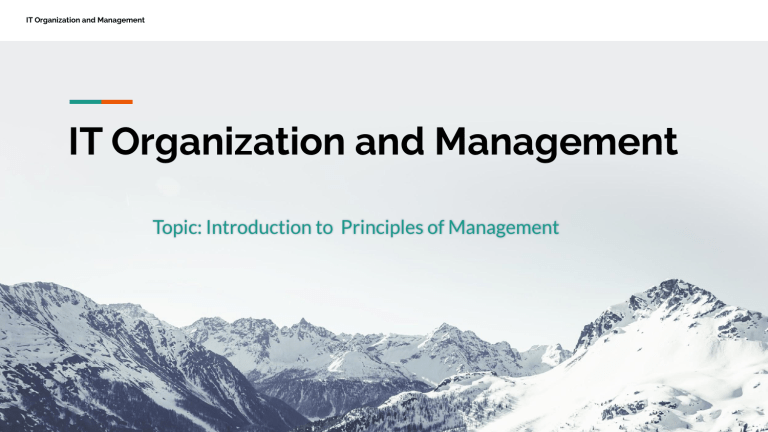
IT Organization and Management IT Organization and Management Topic: Introduction to Principles of Management Contents of this course: Management Planning Organizing IT Project Management Leading IT Industry Scenario Controlling Point of discussion ● ● ● ● ● ● Principle of management Managers Nature of Managerial Work Overview - Leadership, Entrepreneurship, and Strategy Overview - Planning, Organizing, Leading, and Controlling Assess your learning style Management “The art of getting things done through the efforts of other people” Mary Parker Follett: Prophet of Management Principles of Management Activities that “plan, organize, and control the operations of the basic elements of [people], materials, machines, methods, money and markets, providing direction and coordination, and giving leadership to human efforts, so as to achieve the sought objectives of the enterprise.” -Henri Fayol Intro to Principle of Management 1 2 Often discussed or learned using a framework called P-O-L-C, which stands for planning, organizing, leading, and controlling. Managers are required in all the activities of organizations - budgeting, designing, selling, creating, financing, accounting, and artistic presentation 3 4 Everyone employed in an organization is affected by management principles, processes, policies, and practices. Managers do not spend all their time managing. Some employees perform only part of the functions described as managerial. Who Are Managers? Managers We tend to think about managers based on their position in an organization. ➢ ➢ ➢ ➢ Two views of organizations with respect to managerial roles (Ghoshal & Barlett, 1999) are - Traditional and Contemporary. Contemporary: top managers support and serve other managers and employees through Empowerment. Empowerment is the process of enabling or authorizing an individual to think, behave, take action, and control work and decision making in autonomous ways. Traditional: Top managers takes all the decisions and other managers implements those. The Changing Roles of Management and Managers Types of Managers In both views, there are different types of managers ❏ ❏ ❏ ❏ ❏ ❏ ❏ Top managers: ➔ develop the organization’s strategy and act as steward for its vision and mission. Functional managers: ➔ responsible for the efficiency and effectiveness of an area, such as accounting or marketing. Supervisory or team managers: ➔ responsible for coordinating a subgroup. Line managers (Product or Service manager) : ➔ lead a function that contributes directly to the products or services. Staff manager: ➔ lead a function that creates indirect inputs(finance and accounting). Project manager: ➔ responsible for the planning, execution, and closing of any project. This role is common in construction, architecture, consulting, computer networking, telecommunications, or software development. General manager: ➔ responsible for managing a clearly identifiable revenue-producing unit. ➔ typically must make decisions across different functions. take direction from their top executives. ➔ understand the executives’ overall plan for the company. Then they set specific goals for their own departments. Nature of Managerial Work Managerial Roles Managers get activities completed, set and achieve goals through execution of four basic management function - planning, organizing, leading, and controlling Professor Henry Mintzberg conducted a study on manager’s role in the early 1970s. The nature of managerial work found has not changed too much except the inclusion of Empowerment, Technology and Information overload. Role is an organized set of behaviors, and Mintzberg identified 10 roles common to the work of all managers. ➔ ➔ ➔ informational roles link all managerial work together interpersonal roles ensure that information is provided decisional roles make significant use of the information Interpersonal roles of managers - Figurehead - - - - top-level manager represents the company legally and socially to those outside of the organization supervisor represents the work group to higher management and higher management to the work group the manager interacts with peers and people outside the organization top-level manager uses the liaison role to gain favors and information supervisor uses it to maintain the routine flow of work Leader - Liaison defines the relationships between the manager and employees Informational roles of managers - Monitor - the manager transmits special information into the organization top-level manager receives and transmits more information from people outside the organization than the supervisor Spokesperson - manager receives and collects information Disseminator - manager disseminates the organization’s information into its environment top-level manager is seen as an industry expert, while the supervisor is seen as a unit or departmental expert Decisional roles of managers Entrepreneur initiates change deals with threats to the organization Resource Allocator negotiates on behalf of the organization Disturbance Handler chooses where the organization will expend its efforts Negotiator Thinking point Top level managers Vs Supervisory managers ➔ ➔ Which type of managers have more interpersonal or decisional roles? What are their individual emphasis on management of the organization? Leadership, Entrepreneurship & Strategy Leadership ● ● ● ● ● social and informal sources of influence that you use to inspire action taken by others leaders help build an organization’s human capital includes an understanding of when, where, and how to use more formal sources of authority and power good management requires good leaders and leadership Google emphasize leadership in terms of being exceptional at developing people Managers Vs Leaders “My definition of a leader…is a man who can persuade people to do what they don’t want to do, or do what they’re too lazy to do, and like it.” Harry S. Truman (1884–1972), 33rd president of the United States “You cannot manage men into battle. You manage things; you lead people.” Grace Hopper (1906–1992), Admiral, U.S. Navy “A manager takes people where they want to go. A great leader takes people where they don’t necessarily want to go but ought to.” Rosalynn Carter (1927–), First Lady of the United States, 1977–1981 Entrepreneurship ● ● ● ● ● Recognition of opportunities and the use or creation of resources to implement innovative ideas for new, thoughtfully planned ventures. Involves more than simply coming up with a good idea, Identify and create new markets, as well as foster change in existing ones Opportunity-driven nature of entrepreneurship creates values for the organization Opportunities are typically characterized as problems in search of solutions Google’s leaders suggest that its point of distinction “is anticipating needs not yet articulated by our global audience, then meeting them with products and services that set new standards. This constant dissatisfaction with the way things are is ultimately the driving force behind the world’s best search engine” (Google, 2008) Strategy ● ● ● Strategy is the central, integrated, externally-oriented concept of how an organization will achieve its objectives. Strategic management is the body of knowledge that answers questions about the development and implementation of good strategies. Strategy provides leaders and employees with a clear set of guidelines for their daily actions. “A vision without a strategy remains an illusion.” Lee Bolman “Hope is not a strategy.” Vince Lombardi Leadership, Entrepreneurship and Strategy in Management WHO WHAT HOW Leader Entrepreneur Strategic Management Lead the organization forward Identify opportunities and solve problems, define purpose of the organization Make sure that the right choices are made Thinking point ➔ What makes someone a great leader? ➔ Why and how leadership, entrepreneurship and strategy makes a better management system ? Planning, Organizing, Leading, Controlling P-O-L-C Framework Planning ➔ ❖ Setting objectives and determining a course of action Requires that managers be aware of environmental conditions facing their organization and forecast future conditions Environmental Scanning Establish Objectives Forecast Future Constant evaluation Identify alternative courses of action Types of planning Strategic Planning ➔ ➔ ➔ ➔ ➔ ➔ analyzing competitive opportunities and threats analyzing strengths and weaknesses of the organization determining how to position the organization to compete effectively has a long time frame ( more than 3 years ) planning is often based on the organization’s mission top management most often conducts strategic planning Tactical Planning ➔ ➔ ➔ intermediate range time frame ( 1-3 years ) planning relatively concrete and specific means to implement strategic plans middle level managers are mostly engaged in this process Operational Planning ➔ ➔ ➔ short-range time frame (less than a year) specific action steps that support the strategic and tactical plans subunit goals and specific ways to achieve those Organizing ➔ ➔ ➔ Involves developing an organizational structure allocating human resources to ensure the accomplishment of objectives involves the design of individual jobs (duties and responsibilities + how to be carried out) At organization level deciding how best to departmentalize, or cluster, jobs into departments to coordinate effort effectively At job level best design of individual jobs for most effective use of human resources Leading Role of manager: involves the social and informal sources of influence that you use to inspire action taken by others ❖ ❖ Personality Research: understanding subordinates personalities, values, emotion and attitude Motivation: effectively and persuasively communicate to energize subordinates Controlling ensures that performance does not deviate from standards 3 steps of controlling: 1 ❖ ❖ establishing performance standards 2 comparing actual performance against standards 3 taking corrective action when necessary Performance standards are often stated in monetary terms such as - revenue, costs, or profits. Also other terms such as - units produced, number of defective products, or levels of quality or customer service. Role in Controlling ➔ since planning provides the necessary performance standards or objectives ➔ clear understanding of where responsibility for deviations from standards lies ➔ budget audit provides information about where the organization is with respect to what was planned or budgeted for ➔ performance audit might try to determine whether the figures reported are a reflection of actual performance Thinking point ➔ How P-O-L-C model describes the activities of a manager? ➔ Is this model sufficient enough to incorporate all the task of manager? Assess your learning style Learning Style Index (LSI) by (Soloman & Felder, 2008). Link: http://www.engr.ncsu.edu/learningstyles/ Your learning style may be defined in large part by the answers to four questions: 1. 2. 3. 4. How do you prefer to process information: actively—through engagement in physical activity or discussion? Or reflectively—through introspection? What type of information do you preferentially perceive: sensory (external)—sights, sounds, physical sensations? Or intuitive (internal)—possibilities, insights, hunches? Through which sensory channel is external information most effectively perceived: visual—pictures, diagrams, graphs, demonstrations? Or verbal—words, sounds? (Other sensory channels like touch, taste, and smell are relatively untapped in most educational environments, and are not considered here.) How do you progress toward understanding: sequentially—in continual steps? Or globally—in large jumps, holistically? Active Learners Reflective Learners Nature: act before you think Nature: think too much, risk doing nothing ToDo: ToDo: ➔ ➔ ➔ ➔ need to concentrate on summarizing situations If you are in a class that allows little or no class time for discussion or problem-solving activities, you should try to compensate for these lacks when you study. Study in a group in which the members take turns explaining different topics to one another. You will always retain information better if you find ways to do something with it. ➔ ➔ ➔ ➔ involve yourself in group decision making whenever possible If you are in a class that allows little or no class time for thinking about new information, you should try to compensate for this lack when you study don’t simply read or memorize the material; stop periodically to review what you have read and to think of possible questions or applications write short summaries of readings or class notes in your own words Sensory Learners Nature: Nature: ➢ rely too much on sensing ➔ ➔ ➢ rely too much on intuition ToDo: ToDo: ➔ Intuitive Learners Seek out opportunities to learn theoretical information and then bring in facts to support or negate these theories. If you are in a class where most of the material is abstract and theoretical, ask your instructor for specific examples of concepts and procedures, and find out how the concepts apply in practice brainstorming with friends or classmates. ➔ ➔ ➔ force yourself to learn facts or memorize data that will help you defend or criticize a theory or procedure If you are in a class that deals primarily with memorization and rote substitution in formulas, ask your instructor for interpretations or theories that link the facts take time to read the entire question before you start answering, and be sure to check your results. Visual Learners Nature: Nature: ➢ concentrate more on pictorial or graphical information ToDo: ➔ ➔ Verbal Learners ➢ look for opportunities to learn through audiovisual presentations ToDo: try to find diagrams, sketches, schematics, photographs, flowcharts, or any other visual representation of course material that is predominantly verbal prepare a concept map by listing key points, enclosing them in boxes or circles, and drawing lines with arrows between concepts to show connections ➔ ➔ write summaries or outlines of course material in your own words. working in groups can be particularly effective: you gain understanding of material by hearing classmates’ explanations, and you learn even more when you do the explaining. Sequential Learners Nature: ➢ Global Learners Nature: break things down into small components dive right into problem solving ➢ lIf grasping the big picture is easy for you, then you can be at risk of wanting to run before you can walk. ToDo: ToDo: ➔ ➔ ➔ understand why you are doing something and how it is connected to the overall purpose or objective ask yourself how your actions are going to help you in the long run if you are a sequential learner and you have an instructor who jumps around from topic to topic or skips steps, ask the instructor to fill in the skipped steps, or fill them in yourself by consulting references. ➔ ➔ ➔ force yourself to complete all problem-solving steps before coming to a conclusion or making a decision before you begin to study the first section of a chapter in a text, skim through the entire chapter to get an overview instead of spending a short time on every subject every night, you might find it more productive to immerse yourself in individual subjects for large blocks Gauge Discover Reflect take stock of your knowledge and capabilities about a topic learn enough about a topic so that you can set specific development goals on which you can apply and practice, and later gauge again your progress toward your set goals step back and look at the ways you have achieved your goals, take the opportunity to set new ones, and chronicle this experience and thought process in a daily journal Thank you.
